Kuku Sabzi (Persian Herb Frittata)
Kuku sabzi is a classic Persian herb frittata made with loads of fresh herbs, greens and just enough eggs to bind it all together. This flavour-packed dish is perfect for breakfast, brunch or a light lunch. Serve it warm, cold or at room temperature.
Kuku sabzi is a delicious herb frittata bursting with flavour and freshness. This savoury Persian egg dish is made from finely chopped herbs, greens and just enough eggs to hold it all together. It’s perfect for any meal – from breakfast to lunch to dinner.
The key to the best kuku sabzi is the ratio of greens to eggs – which feels like a ridiculous amount of greens – and achieving a dark caramelised crust to contrast the custardy centre.
You can serve kuku warm, at room temperature, or cold – it’s ideal for potlucks, picnics and gatherings. And with a few tips and tricks, this Persian kuku sabzi recipe is also super easy to make.
So grab some fresh herbs, greens and eggs and get ready to make a delicious kuku sabzi.
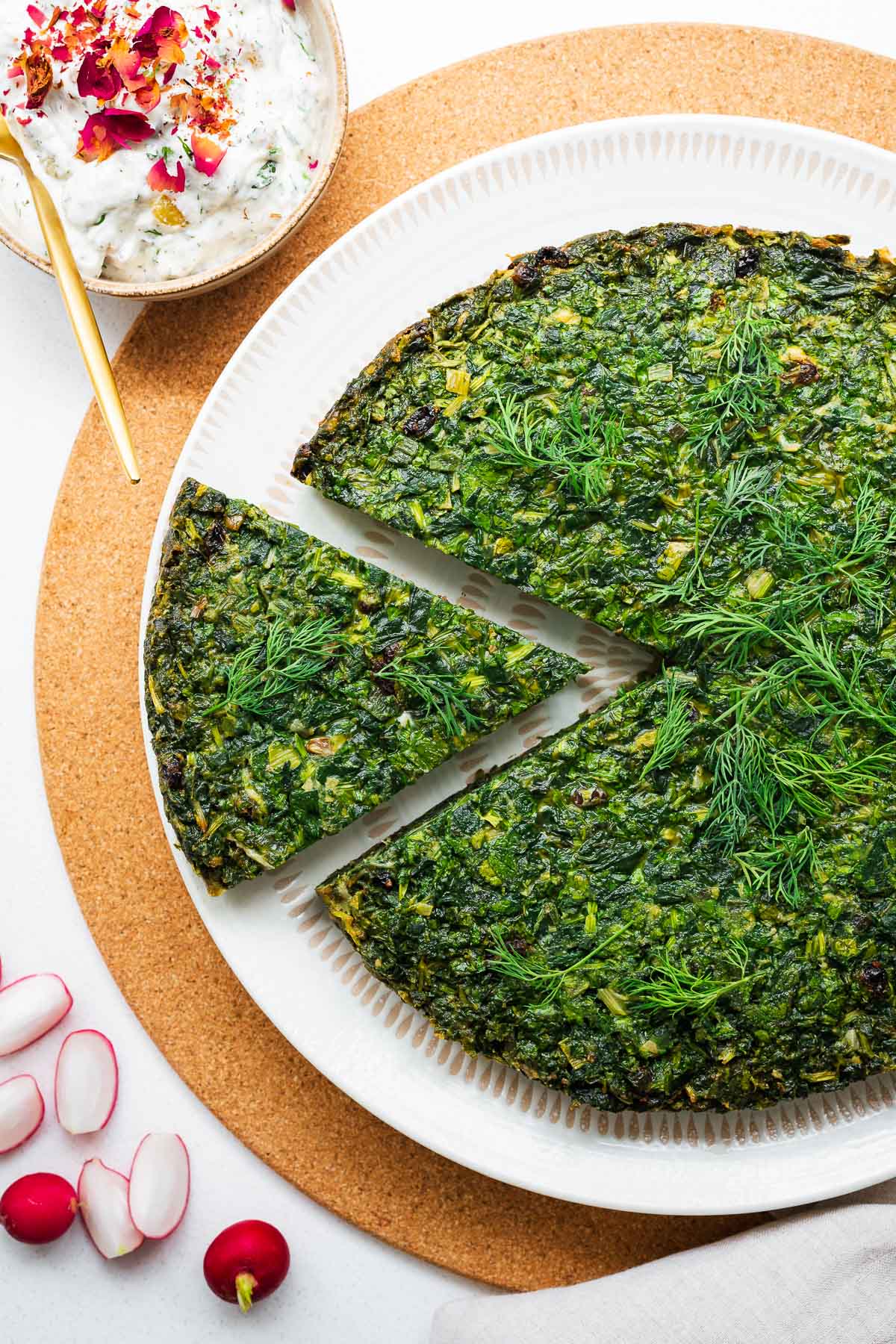
Why you’ll love this recipe
This delicious Persian frittata is full of vibrant herbs with a little acidic kick from barberries (or dried cranberries). It’s a crowd-pleaser you can easily scale to fit the size of your pan.
If you’re not already reaching for the eggs, I have more reasons to love this Persian kuku recipe:
- It’s flavour-packed: Every bite has fresh greens and custardy eggs with a contrasting tart barberry taste.
- It’s easy to make: While it does involve a fair amount of prep, this baked kuku sabzi recipe is super easy to make. There is no intimidating kuku flip, yet you still get that deeply caramelised crust. And most of the prep can be done a day in advance, making this an easy recipe to impress a crowd.
- It’s versatile: Serve the kuku for a delicious Middle Eastern brunch with a generous dollop of mast-o khiar (Persian cucumber and yoghurt), or add Persian rice, a fresh salad or some flatbread to turn it into a main course.
- It’s a showstopper: Because we bake the kuku sabzi in an oven-proof pan, the top is a tapestry of green hues. But you still get that delicious golden crust on the bottom.
What is kuku sabzi?
Kuku sabzi (or kookoo sabzi) is a traditional Persian herb frittata, often served as part of a larger meal for special occasions such as the Persian New Year.
The main ingredients in this savoury Persian egg dish are finely chopped herbs and whole eggs. But optional ingredients – like spinach, barberries, and walnuts – add layers of Persian flavours and textures.
Kuku sabzi is a firm favourite in Persian cuisine. And I can thank Persian chef Samin Nosrat for introducing me to kuku. I adapted this recipe from her “Persian Herb and Greens Frittata” recipe in Salt, Fat, Acid, Heat.
Ingredients and substitutes
The key to making kuku sabzi is the ratio of eggs to herbs – a ratio heavily skewed in favour of the greens. The rest is super flexible. Here are a few substitutes and alternatives you can try.
- Chard leaves: Use Swiss chard, spinach or even Tuscan kale leaves. Or use frozen spinach, thawed, squeezed dry and brought to room temperature. You can also swap the chard for more herbs. But I like to add chard because it is more affordable this way, and it gives the kuku a deep green colour.
- Leek: Samin Nosrat uses leeks in her recipe, and so do I. But you can use any other allium like a small onion, green onions (scallions) or shallots. You can add uncooked green onions to the egg mixture – it saves some time if you’re in a rush.
- Herbs: I use a mix of flat-leaf parsley, cilantro, and fresh dill. But you can adjust the herbs and ratios based on preference and availability. You can also add finely chopped chives to the mix. I also add dried dill, but you can skip it if you don’t have any.
- Baking powder: It gives the eggs a little lift. But you can skip it. Samin’s kuku recipe in Salt, Fat, Acid, Heat omits baking powder, but her kuku recipe on NYT Cooking includes it.
- Fat: A combination of olive oil and butter delivers a golden flavourful crust. But you can omit the butter and use any vegetable oil you prefer to keep things dairy-free.
- Eggs: I use pasture-reared eggs. You should use the eggs you prefer. And don’t worry too much about the size of the eggs. Simply add enough eggs to coat the greens well – it should not be swimming in egg.

Optional add-ins
This simple kuku recipe is vibrant and delicious as is. But there are a few more traditional ingredients you can also add.
Dried barberries: Barberries are small, tart, red berries common in Middle Eastern cuisine. A quarter cup of dried barberries adds a lovely acidic contrast to the fresh herbs and rich eggs. You can also use cranberries (though they are sweeter) or omit the berries.
Substitute tip: If you use dried cranberries instead of barberries, sprinkle them over the egg mixture once in the skillet. Then gently press them just under the surface. They are much sweeter than barberries and will turn bitter if they burn against the hot pan.
Walnuts: Add a quarter cup of chopped walnuts if you want some texture. I prefer to mix the walnuts into a Persian cucumber yoghurt sauce (called mast-o khiar) to serve on the side.
Dried turmeric: A teaspoon ground turmeric adds an earthy flavour and golden colour to the kuku. But I prefer my kuku a bright green colour with a strong herb flavour. The orange yolk of good-quality eggs adds enough warm hues for me, so I skip the turmeric.
Let me know if you try any of the optional add-ins in the comments below.
How to make kuku sabzi
This flavourful traditional Persian egg dish uses a medley of chopped fresh herbs, leeks, and chard. It’s perfect for a special breakfast, brunch, or easy light lunch.
Kuku sabzi requires a mountain of fresh greens. And it can be intimidating when you do it all in one go. So, I like to prep my ingredients when I get home from the market on a Saturday. Then, on Sunday morning, I cook the leeks, mix the ingredients and bake the kuku for an easy Sunday brunch.
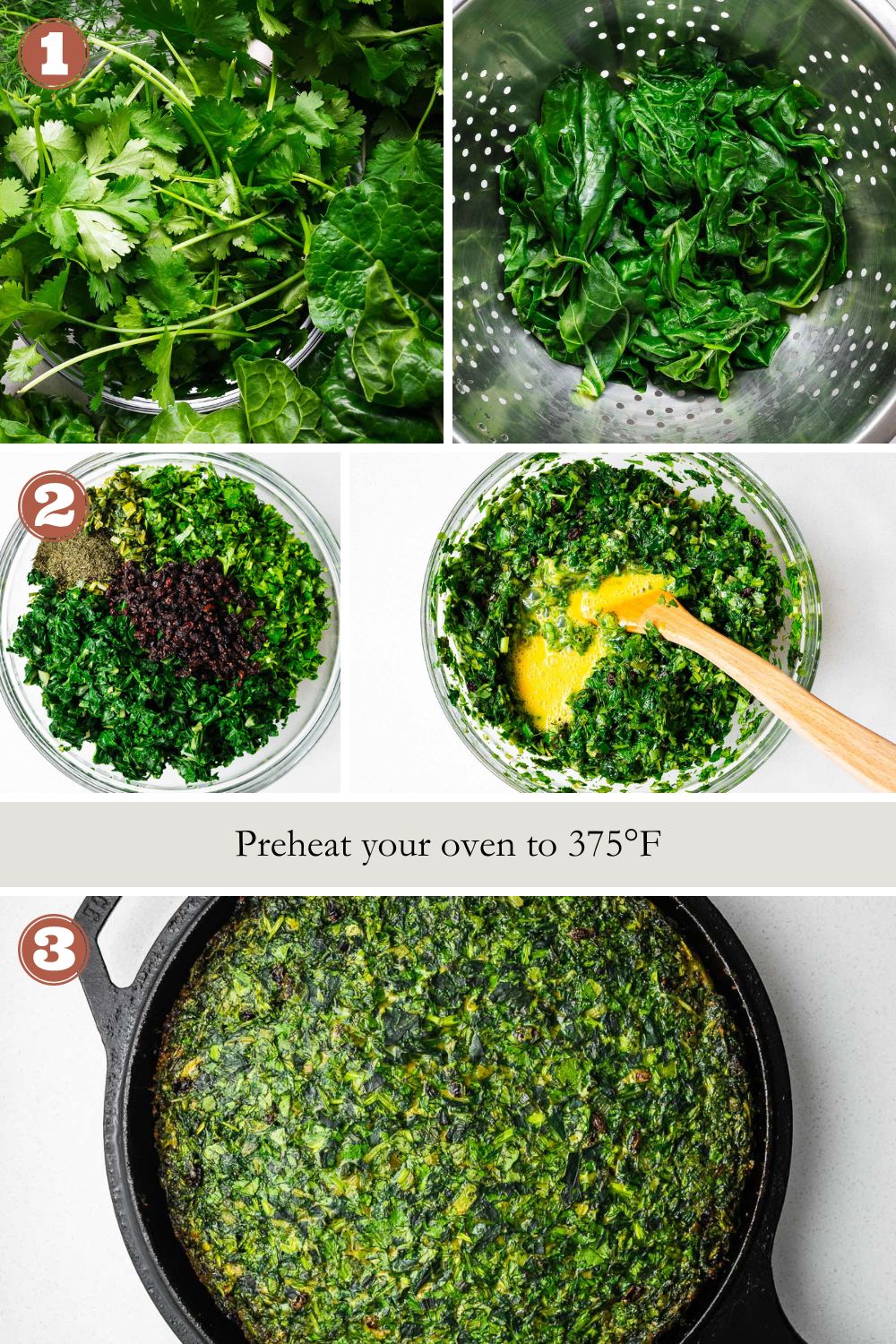
Step 1: Prep the ingredients
Start by prepping your ingredients. Bring salted water to a boil in a large pot and cook the chard or spinach leaves for 2 minutes. Then transfer it to a colander or mesh strainer and set aside to cool down.
Finely chop the leek whites and greens, then wash them really well to get rid of any gritty bits.
Gather the herbs – fresh parsley, cilantro, and dill – and finely chop them. You can also use a food processor fitted with an S-blade for this.
Wash and dry the barberries (if using). There is no need to wash dried cranberries (unless the package instructions say to).
Finally, squeeze the cooked chard leaves dry and discard the liquid. Then chop them coarsely.
Getting ahead: You can do all of this a day ahead of making the kuku. Place the chopped herbs and chard in an airtight container, and keep the leeks in a separate container. Let the ingredients come to room temperature before making the kuku.
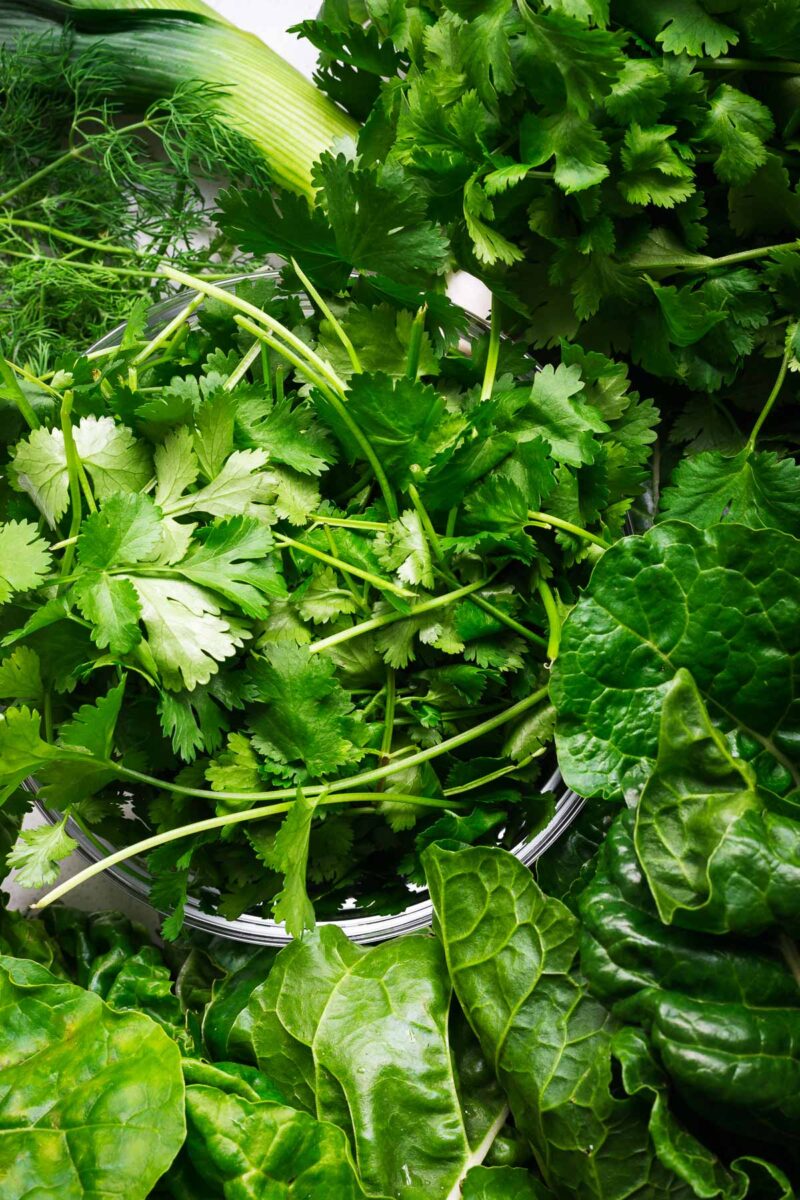
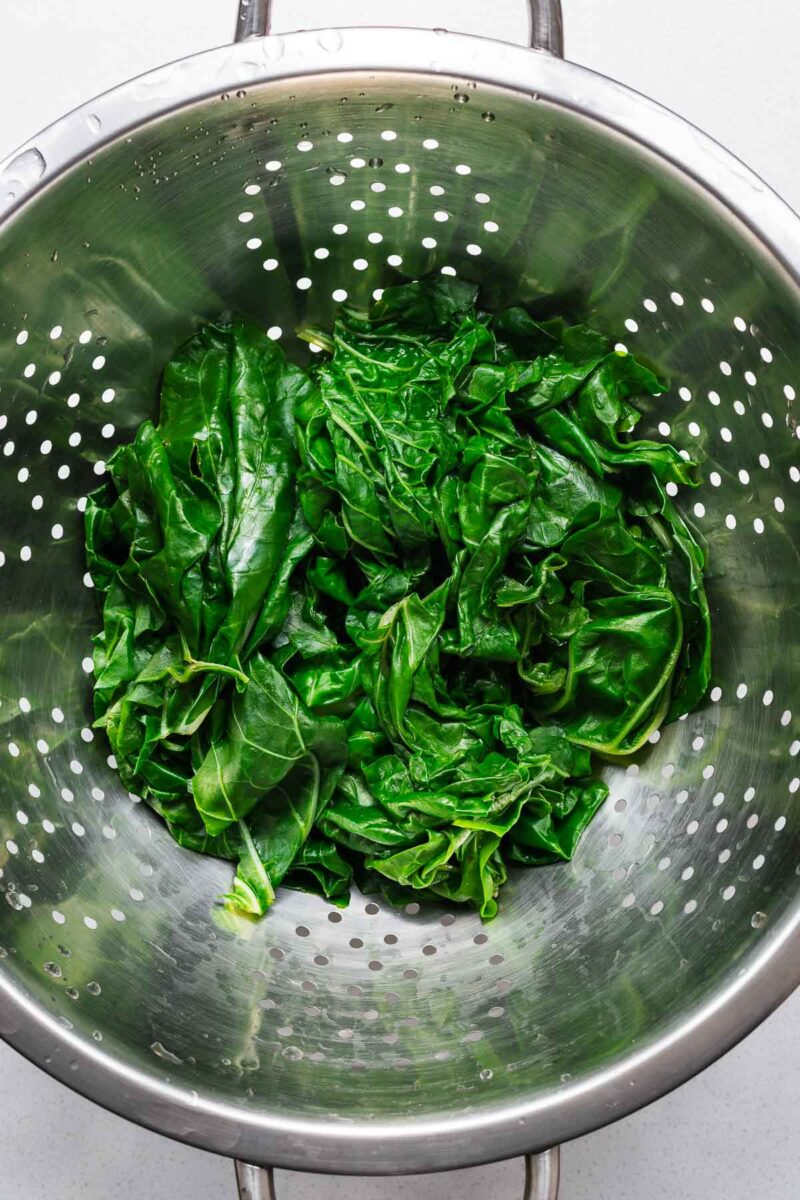
Step 2: Mix the kuku batter
Heat a 10-inch cast iron skillet or oven-proof frying pan over medium heat.
Add a tablespoon each of olive oil and butter. Once the butter melts, add the leeks with a pinch of salt. Cook until tender and translucent, not browned – about 10 to 15 minutes. Turn the heat down if necessary, and add a splash of water if the pan gets too dry.
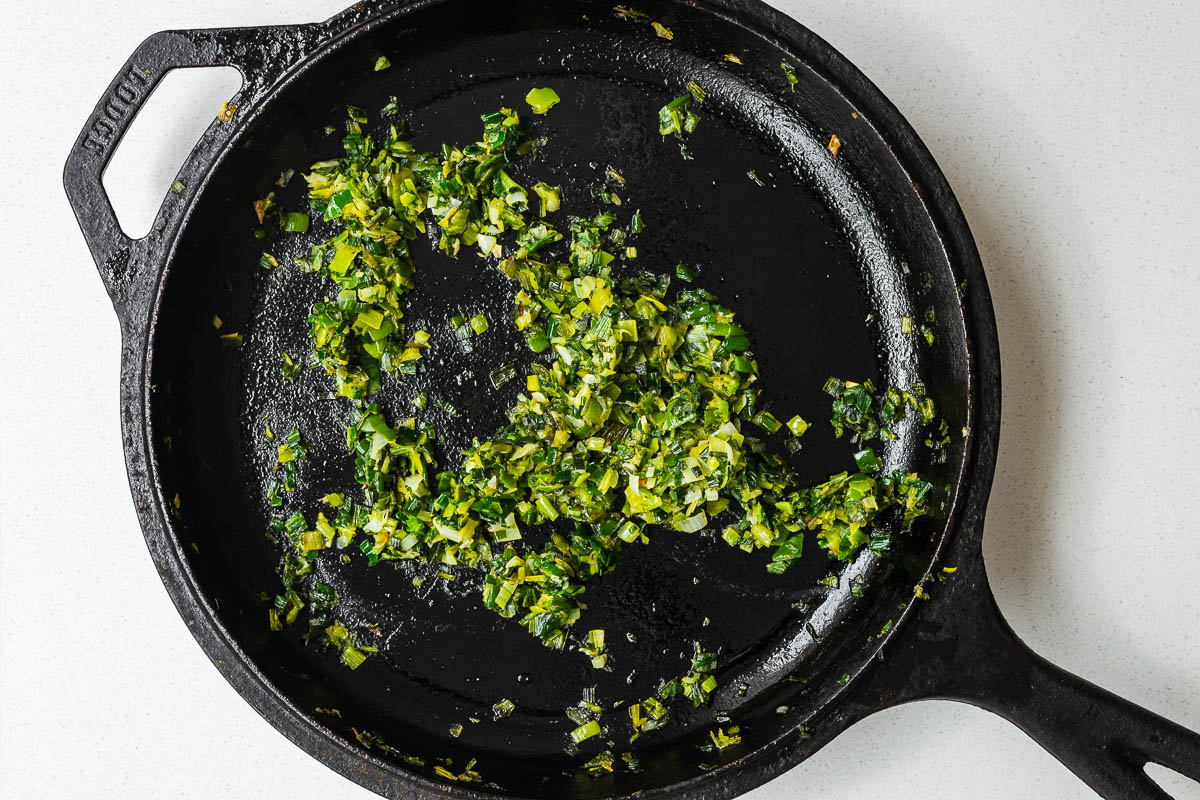
In a large bowl, combine the cooked chard leaves, chopped fresh dill, parsley, cilantro, cooked leeks, barberries (if using) and dried dill. Add a teaspoon salt and a generous grind of black pepper. Pinch a taste, and add more salt if needed – knowing you’re about to add unseasoned eggs. Then sprinkle over the baking powder and mix again.
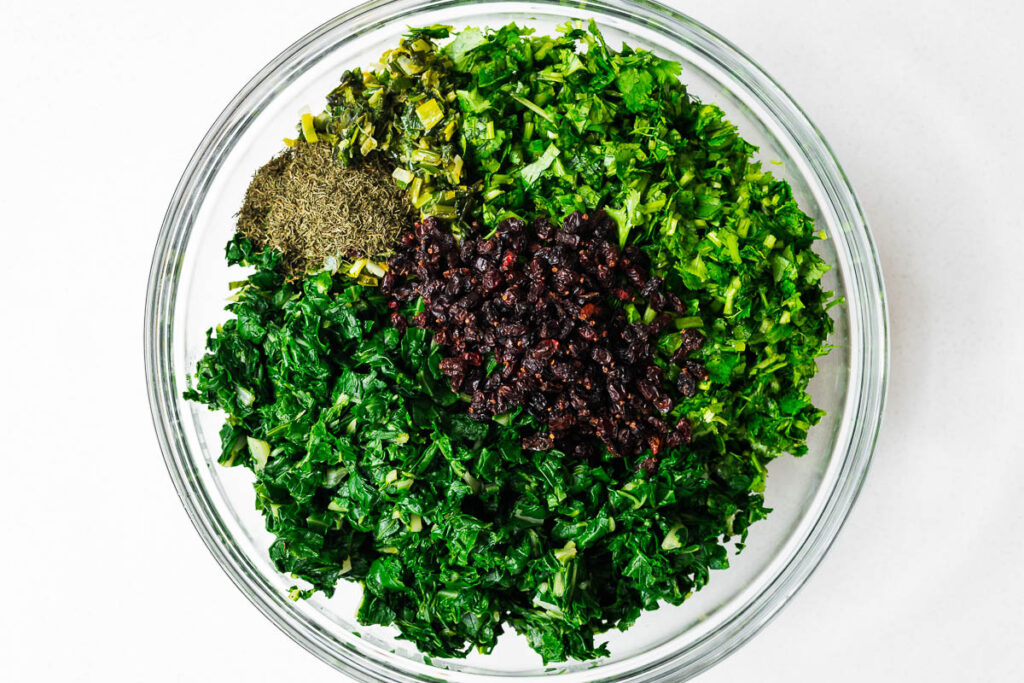
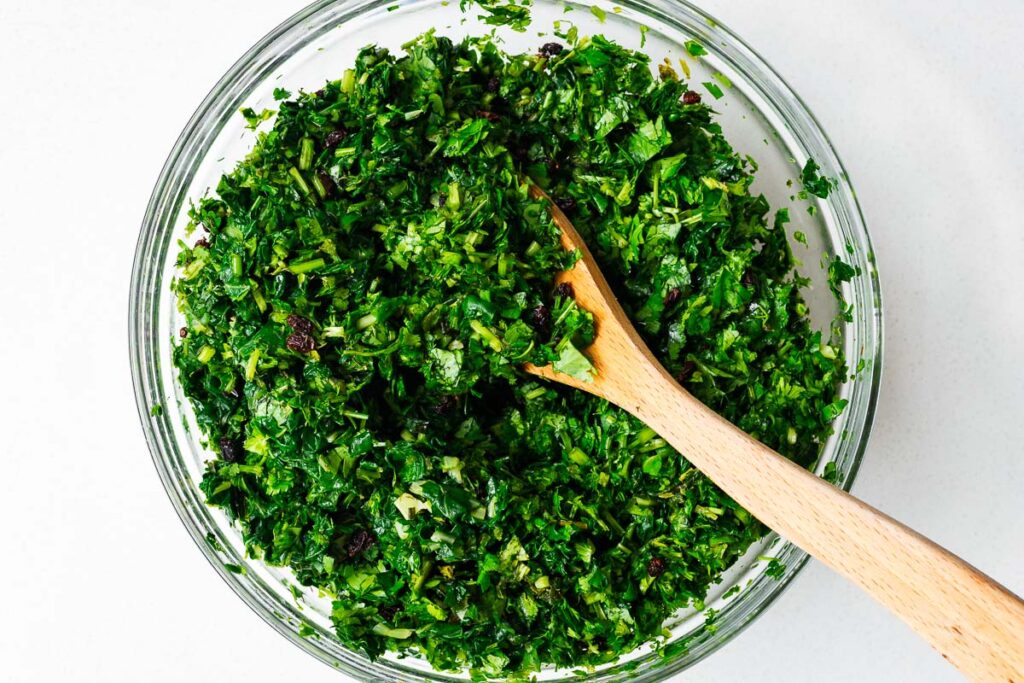
In a medium bowl, whisk together six eggs. Then add it to the spinach and herb mixture. Mix well. Add the last egg only if the mixture looks too dry. It should look like a ridiculous amount of greens coated in egg.

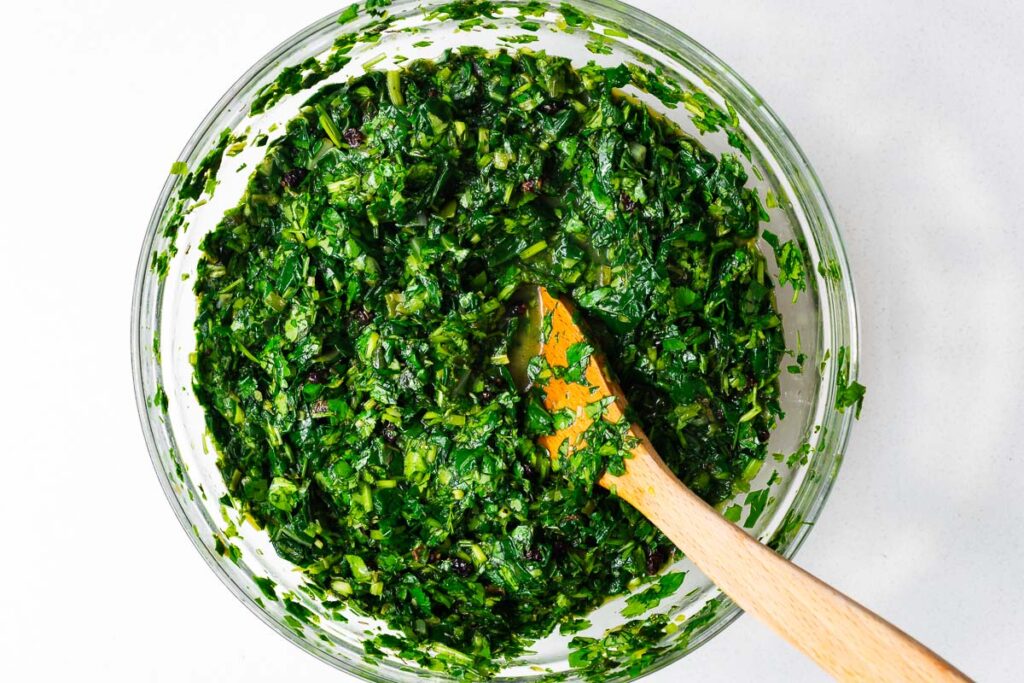
If you’re uncertain whether or not you need to add more eggs, make a dent in the green mixture by pressing down with a spoon. Then let the mixture sit for a few seconds. If you see the egg beginning to pool in the dent, you don’t need more eggs.
Step 3: Bake your kuku
Preheat the oven to 375F, centre rack.
Wipe clean your skillet to ensure your kuku does not stick to the pan. Then reheat the pan over medium-high heat. Once the pan is hot, add a tablespoon olive oil with three tablespoons butter. Once the butter starts to foam, spoon the kuku mixture into the pan, spreading the greens evenly.
Place the pan in the preheated oven and bake until the centre is set but bouncy when pressed with your finger – about 18 to 20 minutes.
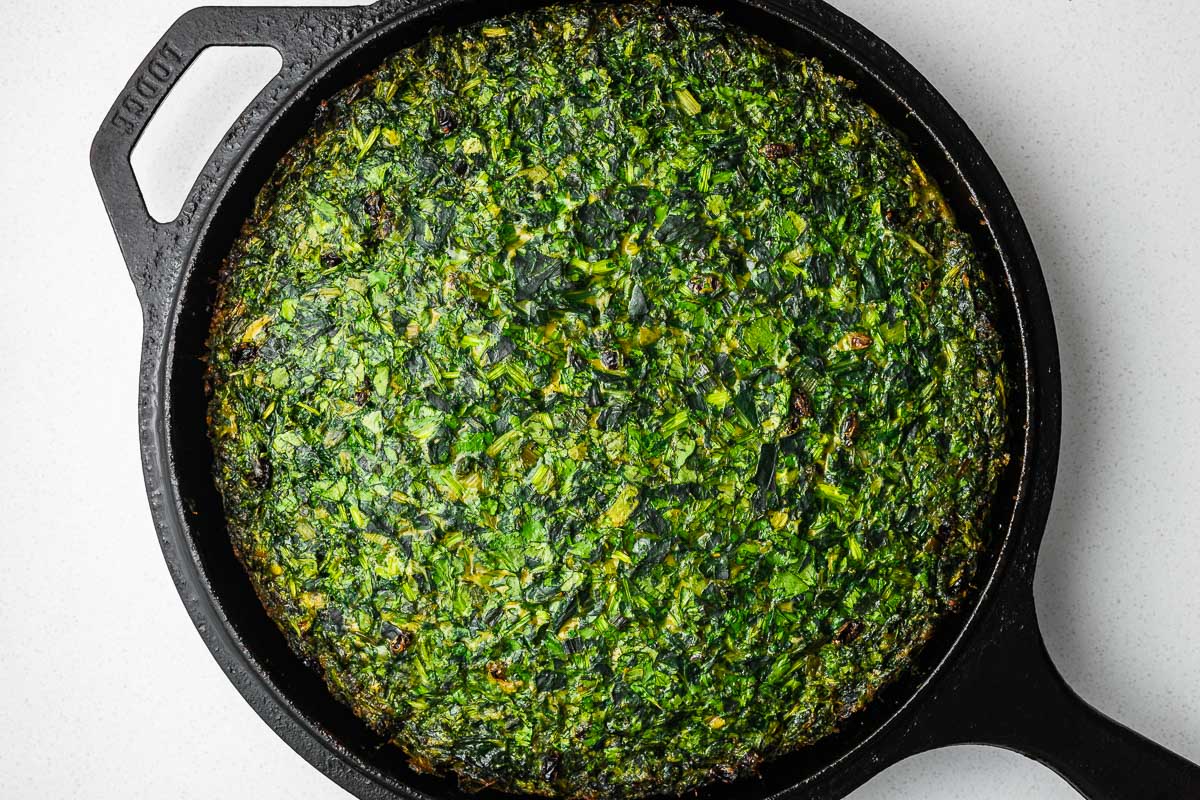
Use a rubber spatula to lift the kuku and sneak a peek at the bottom. If you want a darker bottom, return the pan to the stovetop over medium-high heat for a minute or so. But don’t go too dark – the kuku will stay in the hot pan for another five minutes.
Allow the kuku to cool in the pan for five minutes. Blot away any excess oil and slide (or flip) your kuku onto a serving plate.
Serve warm, at room temperature, or cold with maist-o khiar or yoghurt, radishes, pickles, and warm flatbread.
Tips for perfect kuku
Kuku sabzi can feel intimidating when you first make it. But there is nothing to fear with this easy kuku recipe. Not having to flip the kuku in the pan (the traditional way) makes the kuku recipe foolproof.
Here are some helpful tips and tricks to ensure that your kuku sabzi turns out perfectly every time:
1. Clean and dry your greens
This feels obvious, but there are few things as offputting as grit in your food. So, wash the fresh herbs, chard, and especially the leeks really well.
You also don’t want a watery mix. So, really squeeze all the moisture from the blanched chard and dry your washed herbs before chopping. You can use a salad spinner for this.
2. Finely chop your herbs
You want your herbs very finely chopped for a beautifully green kuku. A food processor makes things easier.
3. Pick the right pan
A 10-inch cast iron skillet (or oven-proof pan) is perfect for this recipe. A 12-inch pan also works, but the kuku will be slightly flatter and will therefore cook faster – check for doneness at 15 minutes.
And if you don’t have a skillet, you can use a regular frying pan for the leeks and bake the kuku in a well-greased cake pan for 25 minutes – it just won’t have the same caramelised crust.
4. Prep the greens ahead of time
You can save time by prepping the vegetables the night before. Pre-blanch the spinach, finely chop the herbs, and dice the leeks.
Store them in separate sealed containers in the fridge. And allow them to come to room temperature before making the kuku, or bake it for an extra minute.
5. Preheat your pan
That golden kuku crust is what sets it apart from a normal frittata. It works best to start with a preheated pan. So, get your pan nice and hot over medium-high heat before you add the olive oil and butter. Then spoon in the kuku mix – spreading it out evenly.
For a deep brown crust, cook the kuku mixture on the stove for five minutes before moving it to the preheated oven for 15 minutes, or until set.
How to serve kuku sabzi
I always serve warm kuku when I’m making brunch for a crowd. It’s delicious with Persian cucumber yoghurt, a zesty chopped salad (like this Arabic salad), and flatbread or pita. Try this easy no-yeast yoghurt flatbread recipe if you want to make flatbread from scratch.
Kuku sabzi is also delicious at room temperature – perfect for a summer picnic.
You can refrigerate leftovers in an airtight container for three days.
Use leftover kuku for tasty kuku sandwiches. Slice the leftover kuku into strips or cubes and stuff it between two slices of fluffy bread with sliced pickles. Or shove it into a pita pocket with harissa hummus and lemon tahini sauce. Lunch sorted.

Frequently asked questions
Kuku is a traditional Persian egg dish made with a mixture of vegetables and herbs, such as potatoes, eggplant, leeks, parsley, coriander, dill, spinach, or chives. It is a favourite side dish during special occasions such as the Persian new year.
Kuku is made by combining chopped vegetables and herbs with eggs, and other optional ingredients like barberries and walnuts. The mixture is cooked in a hot pan and flipped to create a deep brown crust on both sides of the kuku.
Kuku comes in many variations. Kuku sabzi (made with fresh herbs) is the most common type of kuku. But there is also potato kuku (kuku sibzamini), eggplant kuku (kuku-ye bādenjān), roe kuku (ašbal kuku), and yoghurt kukku (kuku-ye māst).
Middle Eastern recipes to serve with kuku sabzi
- Harissa roasted cauliflower: A buttery, spicy and indulgent vegetarian main to serve with Persian yoghurt.
- Barley pilaf with rose harissa: An easy Middle Eastern pilaf to pair with mast-o khiar.
- Persian eggplant stew: Slow-roasted eggplant stew with lentils and black lime.
- Arabic salad: A classic Middle Eastern-style chopped salad to serve alongside the yoghurt side dish.
- Mast-o khiar: A refreshingly sweet and savoury Persian yoghurt and cucumber sauce.

Equipment
- 10.25-inch cast iron skillet , see notes if you don't have an oven-proof frying pan
Ingredients
- 1 pound chard leaves , or spinach leaves
- 1 leek , whites and greens finely diced and washed
- 2 tablespoons olive oil , divided
- 4 tablespoons butter , divided
- 2 cups finely chopped parsley , leaves and tender stems
- 2 cups finely chopped cilantro , leaves and tender stems
- 1 cup finely chopped dill , leaves and tender stems
- ¼ cup dried barberries* (optional) , rinsed and dried
- 2 teaspoons dried dill
- ½ teaspoon baking powder
- 7 large eggs
- salt and freshly ground black pepper
To Serve (optional)
- mast-o khiar , or yoghurt
- radishes
- Middle Eastern pickles , or cornichons
- flatbread , or pita
Instructions
- Preheat the oven to 375 °F, centre rack.
- Bring salted water to a boil in a large pot – I use roughly one teaspoon per quart (litre). Cook the chard leaves for 2 minutes. Then transfer it to a colander or mesh strainer and set it aside to cool down.
- Heat a 10-inch cast iron skillet* or oven-proof frying pan over medium heat. Add 1 tablespoon each of olive oil and butter. Once the butter melts, add the leeks with a pinch of salt. Cook until tender and translucent, not browned – about 10 to 15 minutes. Turn the heat down if necessary, and add a splash of water if the pan gets too dry.
- Squeeze the cooked chard leaves dry and discard the liquid. Then chop them coarsely. Add to a large bowl with the chopped herbs and tip in the cooked leeks. Add the barberries (if using) and dried dill. Then mix thoroughly – I use my hands for this. Add a teaspoon of salt and a generous grind of black pepper. Pinch a taste, and add more salt if needed – knowing you’re about to add unseasoned eggs. Then sprinkle over the baking powder and mix again.
- In a medium bowl, whisk together 6 eggs (setting one egg aside). Then add it to the spinach and herb mixture. Mix well. Add the last egg only if the mixture looks too dry. It should look like a ridiculous amount of greens coated in egg. This ratio of greens to egg sets kuku sabzi apart from a standard herb frittata.
- Wipe clean your skillet – to ensure that your kuku does not stick to the pan – and reheat the pan over medium-high heat. Once the pan is hot, add a tablespoon of olive oil with three tablespoons of butter. When the butter starts to foam, spoon the kuku mixture into the pan, spreading the greens evenly.
- Place the pan in the preheated oven and bake until the centre is set but bouncy when pressed with your finger – about 18 to 20 minutes. Use a spatula to lift the kuku and sneak a peek at the bottom. If you want a darker bottom, return the pan to the stovetop over high heat for a minute or so. Allow the kuku to cool in the pan for another 5 minutes.
- Blot away any excess oil and slide (or flip) your kuku onto a serving plate. Serve warm, at room temperature, or cold with maist-o khiar or yoghurt, radishes, pickles, and warm flatbread.
Notes
- Barberries are small, tart, red berries common in Middle Eastern cuisine. They add a lovely acidic contrast to the fresh herbs and rich eggs. You can also use cranberries (though they are sweeter) or omit the berries. See the ingredients section of the blog post for more substitutes and recipe variations.
- Adjust the ratios of the different fresh herbs based on the flavours you prefer and what you have access to.
- There are loads of fresh herbs to process. You can use a food processor fitted with an S-blade to chop them. Just don’t be tempted to use a blender.
- Scale the recipe to fit the size of your pan – a 10-inch skillet is perfect for the recipe as written. Either tap the serving size indicator in the recipe card and drag to scale or simply use just enough eggs to coat the chopped greens.
- If you don’t have an oven-proof pan like a cast-iron skillet, you can bake the kuku in a well-greased cake pan. It won’t have the same caramelisation on the crust, but it will still be utterly delicious. Add the kuku mixture to the cake pan and bake for 20 to 25 minutes at 375 °F.
- To cook kuku on the stove only: Use a frying pan over medium heat and cook it for 10 minutes – constantly checking that the bottom does not burn and adjusting the heat accordingly. Then flip the kuku by sliding it onto a baking sheet, flipping it onto a plate or cookie sheet, and then sliding it back into the pan. It is the traditional method, but the flipping part can be intimidating.
- Prep time depends on whether you need to strip the spinach leaves or buy them pre-processed. And the same is true for the herbs. I like to get ahead and prep my greens the day before I make the kuku. It’s a breeze if you start with chopped herbs and blanched spinach. Cover and refrigerate the prepared greens and bring them to room temperature before making the kuku.
- Refrigerate leftovers in an airtight container for up to 3 days. Serve cold or reheated.
Have eggs? Explore more recipes with lots of eggs:
- Mayak eggs (Korean soy-marinated eggs)
- Chinese tomato egg stir-fry (and try tomato egg drop soup with the same ingredients)
- Shakshuka with feta and rose harissa

This Kuku Sabzi recipe is fantastic! It’s easy to follow and results in a flavorful, herb-packed dish that’s perfect for any meal. A delightful way to enjoy fresh greens. Thank you!
I’m so happy you loved the kuku recipe, Heather!